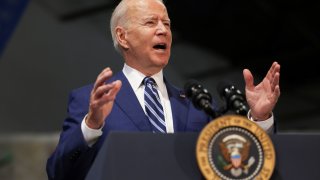
- Biden's budget incorporates his two signature domestic proposals, the American Families Plan and the American Jobs Plan, neither of which has been seriously debated by Congress yet.
- The topline budget request for 2022 is $6 trillion. But of this, only $300 billion is new spending requested for next year.
- It also factors in an increase in the corporate tax rate to 28% from 21%.
WASHINGTON — President Joe Biden released his fiscal year 2022 budget request to Congress on Friday, the first formal budget of his presidency and a sharp departure from his predecessor Donald Trump.
Biden's budget incorporates his two signature domestic proposals, the American Families Plan and the American Jobs Plan, neither of which has been seriously debated by Congress yet.
329 medal events. 32 sports. Endless drama. Catch all the action at the Paris Olympics. Sign up for our free Olympics Headlines newsletter.
It also illustrates how different Biden's priorities are from Trump's. For example, it requests an increase of 41% for the Department of Education over last year, plus 23% more for the Department of Health and Human Services, and 22% more for the Environmental Protection Agency.
Funding for the Department of Homeland Security, which carried out Trump's aggressive immigration policies, would decrease by a tenth of a percent. Another Trump priority, the Department of Defense, would see an increase in funding of just 2%.
On a personal level, Biden views his budget as a reflection of his values. He often quotes his own father as having said, "Don't tell me what you value. Show me your budget, and I'll tell you what you value."
Local
The topline budget request for 2022 is $6 trillion. But of this, only $300 billion is new spending requested for next year. Instead, as in every presidential budget, the vast majority of the money in it will be spent on programs the government is obligated by law to fund, such as Medicare, Social Security and interest on the national debt.
All told, around $1.5 trillion was requested for discretionary items in FY 2022, which includes the funding of all federal agencies. Approximately half of that is already marked for the Defense Department.
On the pay-for side, Biden's budget incorporates a wide variety of changes to the tax code that the White House says can fund his multitrillion-dollar domestic spending plans. Chief among these are an increase in the corporate tax rate from 21% to 28%, as well as increased IRS enforcement and higher taxes on the wealthiest taxpayers.
The tax changes also include a set of "Made in America" tax changes that penalize U.S. companies for offshoring jobs, especially to make goods that are then sold back to American consumers.
As with most presidential budgets, the White House relies on optimistic projections of low unemployment and low inflation rates to help make the cast that Biden's spending plans will pay for themselves via increased growth.
Unemployment, the White House projects, will fall to 4.7% by the end of the year, 4.1% in 2022 and 3.8% the following year. After that, it projects unemployment will remain at a very low 3.8% for the ensuing seven years.
Also in the White House budget is a projection that inflation this year will be 2.1%, and it won't rise to more than 2.3% a year over the next 10 years.
But numbers this low are difficult to justify: The current unemployment rate is 6.1% and the current inflation rate is 4.2%, significantly higher than the White House estimate.
Jared Bernstein, a member of the president's Council of Economic Advisers, acknowledged the problem with the inflation forecast on Friday in an interview on CNBC's Closing Bell.
Bernstein said the economic predictions for the budget had been compiled in February of this year, when inflation rates were still low. Were they to be written now, he said, they would factor in the higher inflation rates.
Speaking to reporters prior to the release of the plan Friday, Cecilia Rouse, the chair of Biden's Council of Economic Advisers, said that historically low interest rates make now an ideal time for the federal government to take on additional debt to modernize the economy and expand the social safety net.
Shalanda Young, the acting director of OMB, said interest rates will rise slightly over time, but she believes they will remain comparatively low thanks to "a global, persistent phenomenon" of lower interest.
The White House projects that over time, Biden's proposals would increase productivity and consumer spending enough to pay for themselves and eventually decrease the deficit in 15 years.
Biden's budget has already come under scrutiny from some progressives, who note that it does not include a health-care public option, which was one of Biden's campaign pledges.
White House officials said Biden would instead look to Congress to help him create a public option and to pass a bill that permits Medicare to negotiate with pharmaceutical companies on drug prices.
Like all presidential budgets, Biden's is one part plan and one part wish list, intended to illustrate the president's policy priorities as much as it is to inform congressional appropriators.
Dependent upon Congress to actually get passed into law, Biden's budget will likely be altered in ways big and small before it is finally appropriated by Congress. But with Democrats in control of both chambers this year, Biden has a far better chance of seeing his major priorities reflected in the final outcome than most of his recent predecessors did.
In a statement accompanying the release of the budget, the president said the document is "a budget for what our economy can be, who our economy can serve, and how we can build it back better by putting the needs, goals, ingenuity, and strength of the American people front and center."
You can read the president's entire budget here.



